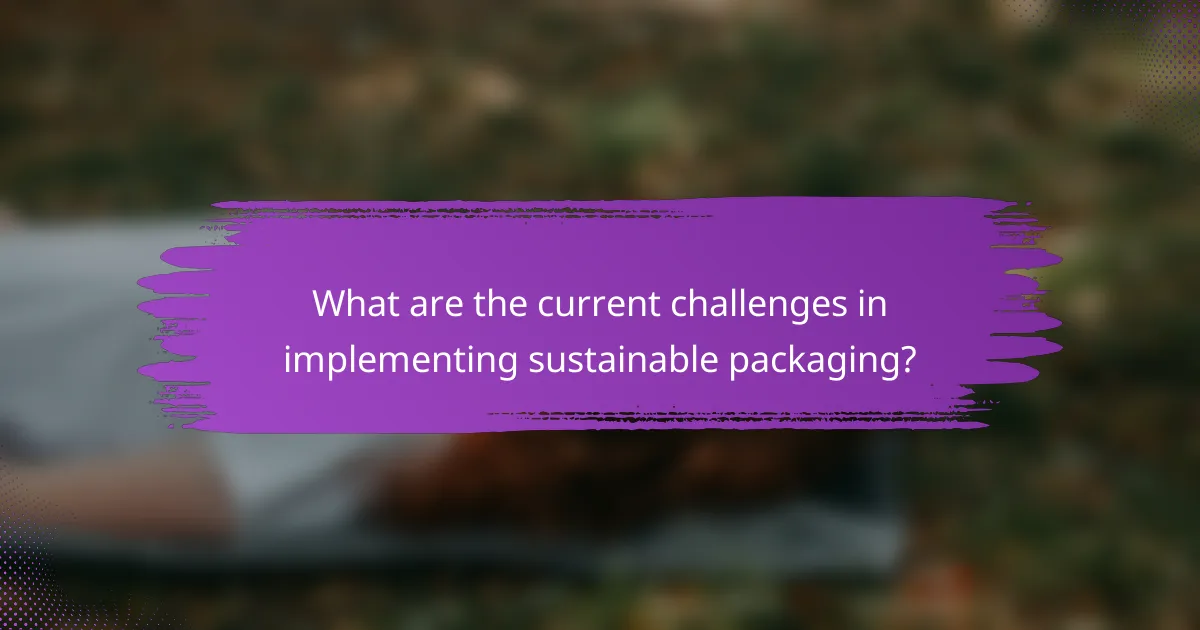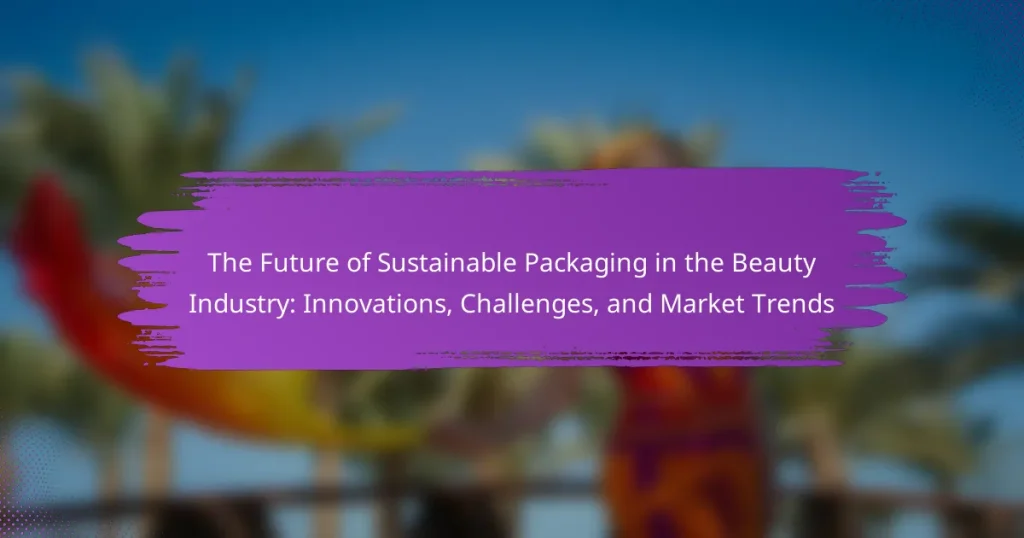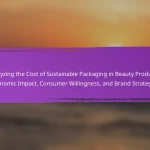Sustainable packaging in the beauty industry encompasses eco-friendly packaging solutions designed to reduce environmental impact through the use of recyclable, biodegradable, and renewable materials. The article explores the increasing adoption of these practices by brands in response to consumer demand and regulatory pressures, highlighting successful examples such as Lush and Aveda. Key challenges to implementing sustainable packaging include high costs, limited material availability, varying consumer acceptance, and complex regulatory compliance. Additionally, the piece examines market trends, noting that a significant percentage of consumers, particularly millennials, are willing to pay more for sustainable options, positioning sustainability as a crucial differentiator as the beauty industry approaches a projected $1 trillion valuation by 2025.

What is Sustainable Packaging in the Beauty Industry?
Sustainable packaging in the beauty industry refers to packaging solutions that minimize environmental impact. This includes using materials that are recyclable, biodegradable, or made from renewable resources. Brands are increasingly adopting these practices to reduce waste and carbon footprints. For instance, a study by McKinsey & Company found that 60% of consumers prefer sustainable packaging options. This shift is driven by consumer demand for eco-friendly products and regulatory pressures. Sustainable packaging not only benefits the environment but also enhances brand loyalty. Brands like Lush and Aveda exemplify successful implementation of sustainable packaging in their product lines.
Why is sustainable packaging important for the beauty industry?
Sustainable packaging is important for the beauty industry because it reduces environmental impact. The beauty sector generates significant waste, with millions of plastic containers ending up in landfills annually. Transitioning to sustainable materials can minimize this waste. According to a report by McKinsey, 60% of consumers prioritize sustainability in their purchasing decisions. This shift influences brand loyalty and purchasing behavior. Sustainable packaging also aligns with regulatory trends aimed at reducing plastic usage. Brands adopting eco-friendly practices can enhance their market competitiveness. Therefore, sustainable packaging is crucial for environmental responsibility and consumer preference in the beauty industry.
What are the environmental impacts of traditional beauty packaging?
Traditional beauty packaging has significant environmental impacts. It often consists of non-biodegradable materials like plastic and glass. These materials contribute to landfill waste and pollution. According to a report by the Ellen MacArthur Foundation, beauty packaging is a major contributor to plastic pollution. Approximately 120 billion units of packaging are produced annually by the beauty industry. Many of these packages are used only once and discarded. This leads to increased carbon emissions during production and disposal. Moreover, traditional packaging often lacks recycling options, exacerbating environmental harm.
How does sustainable packaging contribute to a circular economy?
Sustainable packaging contributes to a circular economy by minimizing waste and promoting resource efficiency. It is designed for reuse, recycling, or composting, reducing the need for new materials. This approach decreases environmental impact and conserves natural resources. Research indicates that using recycled materials in packaging can reduce greenhouse gas emissions by up to 30%. Additionally, sustainable packaging encourages companies to adopt responsible production practices. By integrating circular principles, businesses can create long-lasting products that support sustainability. This shift not only benefits the environment but also meets consumer demand for eco-friendly options.
What are the key innovations in sustainable packaging for beauty products?
Key innovations in sustainable packaging for beauty products include biodegradable materials, refillable containers, and reduced plastic usage. Biodegradable materials, such as plant-based plastics, decompose naturally, minimizing environmental impact. Refillable containers encourage consumers to reuse packaging, reducing waste significantly. Companies are also utilizing recycled materials, which lowers the demand for virgin plastic. Smart packaging technology, like QR codes, enhances consumer engagement and promotes recycling. Minimalist designs reduce material usage while maintaining functionality. These innovations collectively aim to create a circular economy in the beauty industry, aligning with sustainability goals.
What materials are being used for sustainable beauty packaging?
Bioplastics, recycled paper, glass, and aluminum are commonly used for sustainable beauty packaging. Bioplastics are derived from renewable sources, reducing reliance on fossil fuels. Recycled paper is biodegradable and can be produced with minimal environmental impact. Glass is recyclable and reusable, making it a durable option. Aluminum is lightweight and can be recycled indefinitely without loss of quality. These materials help minimize waste and promote a circular economy in the beauty industry.
How are brands incorporating technology into sustainable packaging solutions?
Brands are incorporating technology into sustainable packaging solutions by utilizing biodegradable materials and smart packaging innovations. Companies are developing packaging made from plant-based plastics that decompose naturally. They are also integrating QR codes and NFC technology to enhance consumer engagement and provide information on recycling. Advanced printing techniques are being employed to reduce ink usage and minimize waste. Some brands are using augmented reality to showcase product benefits and sustainability efforts. Research indicates that 74% of consumers prefer brands that use eco-friendly packaging. This shift is driven by consumer demand for transparency and environmental responsibility.

What are the current challenges in implementing sustainable packaging?
The current challenges in implementing sustainable packaging include high costs, limited material availability, and consumer acceptance. High costs often deter companies from adopting sustainable options. Limited availability of eco-friendly materials restricts production capabilities. Consumer acceptance varies, as some customers prioritize convenience over sustainability. Additionally, regulatory compliance can be complex and inconsistent across regions. The lack of standardized definitions for sustainable packaging further complicates implementation. Lastly, supply chain disruptions can hinder the sourcing of sustainable materials. These challenges collectively impact the transition to sustainable packaging in the beauty industry.
What barriers do beauty brands face in adopting sustainable packaging?
Beauty brands face several barriers in adopting sustainable packaging. High costs associated with sustainable materials often deter brands from making the switch. Many sustainable options are more expensive than traditional packaging materials. Limited availability of sustainable materials can also pose a challenge. Not all suppliers offer eco-friendly alternatives, which restricts options for brands.
Consumer demand for aesthetic appeal complicates the transition. Brands worry that sustainable packaging may not meet visual expectations. Regulatory complexities add another layer of difficulty. Navigating compliance with various environmental regulations can be daunting for brands. Additionally, the lack of industry standards for what constitutes sustainable packaging leads to confusion. This inconsistency can hinder brands’ decision-making processes.
Finally, the need for consumer education cannot be overlooked. Many consumers are not fully aware of the benefits of sustainable packaging. This lack of awareness can affect purchasing decisions and brand loyalty.
How do cost factors affect the transition to sustainable packaging?
Cost factors significantly influence the transition to sustainable packaging. Higher initial costs for sustainable materials deter companies from adopting eco-friendly options. For example, bioplastics can be 30-50% more expensive than conventional plastics. Additionally, the supply chain for sustainable packaging may not be fully developed, leading to higher logistics costs. Companies often weigh these costs against potential long-term savings and consumer demand for sustainable products. Research shows that 66% of consumers are willing to pay more for sustainable brands. Thus, cost factors play a crucial role in decision-making for businesses transitioning to sustainable packaging.
What role does consumer awareness play in the adoption of sustainable packaging?
Consumer awareness significantly drives the adoption of sustainable packaging. When consumers are informed about environmental impacts, they tend to prefer eco-friendly options. This preference influences brands to adopt sustainable practices to meet consumer demand. A study by Nielsen found that 73% of millennials are willing to pay more for sustainable products. Increased awareness leads to higher expectations for brands regarding sustainability. As a result, companies are motivated to innovate and improve their packaging solutions. Consumer awareness thus acts as a catalyst for change in the beauty industry.
How are regulations impacting sustainable packaging in the beauty industry?
Regulations are driving significant changes in sustainable packaging within the beauty industry. These regulations often mandate reductions in plastic use and promote recyclable materials. For instance, the European Union’s Single-Use Plastics Directive aims to minimize plastic waste. Brands are now required to meet specific sustainability criteria to comply with these laws. This has led to increased investment in eco-friendly packaging solutions. Many companies are transitioning to biodegradable or compostable materials. Additionally, consumer demand for sustainable practices is influencing regulatory frameworks. As a result, brands that do not adapt may face penalties or loss of market share.
What are the key regulatory frameworks influencing packaging choices?
Key regulatory frameworks influencing packaging choices include the European Union’s Packaging and Packaging Waste Directive. This directive mandates that packaging must be designed to minimize environmental impact. It requires recyclability and reduced use of hazardous substances. The U.S. Environmental Protection Agency (EPA) also regulates packaging through waste management guidelines. These guidelines encourage sustainable practices and recycling initiatives. Additionally, the Federal Trade Commission (FTC) oversees claims related to environmental benefits in packaging. Compliance with these regulations is essential for companies in the beauty industry to ensure sustainability and market acceptance.
How can brands navigate compliance while innovating in packaging?
Brands can navigate compliance while innovating in packaging by integrating regulatory guidelines into their design processes. This involves staying updated on local and international packaging regulations. Brands should also collaborate with legal experts to ensure compliance throughout the packaging lifecycle. Utilizing sustainable materials that meet regulatory standards can enhance innovation and compliance simultaneously. Conducting thorough market research helps identify compliance trends and consumer preferences. Testing packaging prototypes for regulatory adherence is essential before launch. Engaging with industry associations can provide valuable insights into compliance best practices. Continuous monitoring of regulatory changes ensures that brands remain compliant as they innovate.

What are the market trends driving sustainable packaging in beauty?
Consumer demand for eco-friendly products is driving sustainable packaging in beauty. Brands are increasingly adopting biodegradable materials. This shift aligns with growing environmental awareness among consumers. Research indicates that 73% of millennials are willing to pay more for sustainable products. Companies are also focusing on reducing plastic waste. Initiatives include using refillable packaging and minimizing excess materials. Regulatory pressures are pushing brands towards sustainability as well. The beauty industry is projected to reach $1 trillion by 2025, with sustainability being a key differentiator.
How are consumer preferences shaping the future of beauty packaging?
Consumer preferences are significantly influencing the future of beauty packaging. Increasing demand for sustainability is driving brands to adopt eco-friendly materials. Many consumers prefer recyclable or biodegradable packaging options. Research indicates that 75% of consumers are willing to pay more for sustainable packaging. Transparency in sourcing and production processes is also becoming important. Brands that communicate their sustainability efforts effectively gain consumer trust. Customization and personalization in packaging are rising trends as well. This shift reflects a broader movement towards responsible consumption in the beauty industry.
What demographic shifts are influencing sustainable packaging choices?
Younger consumers are increasingly influencing sustainable packaging choices. This demographic prioritizes environmental consciousness. Millennials and Generation Z show a strong preference for eco-friendly products. Research indicates that 73% of younger consumers are willing to pay more for sustainable packaging. Additionally, urbanization has shifted consumer behaviors towards sustainability. Increased access to information drives awareness about environmental issues. Social media amplifies the demand for brands to adopt sustainable practices. Consequently, brands are adapting their packaging strategies to align with these demographic trends.
How is the rise of eco-conscious consumers affecting brand strategies?
The rise of eco-conscious consumers is significantly reshaping brand strategies in the beauty industry. Brands are increasingly prioritizing sustainability in their product offerings. This includes using eco-friendly materials for packaging and formulating products with natural ingredients. Companies are also enhancing transparency regarding their sourcing and manufacturing processes. Research indicates that 66% of global consumers are willing to pay more for sustainable brands. Additionally, brands that adopt sustainable practices often see increased customer loyalty and positive brand perception. This trend is driving innovation in sustainable packaging solutions, which are becoming essential for market competitiveness.
What are the emerging trends in sustainable packaging design?
Emerging trends in sustainable packaging design include the use of biodegradable materials, minimalistic packaging, and refillable systems. Biodegradable materials, such as plant-based plastics, are gaining popularity for their reduced environmental impact. Minimalistic packaging focuses on reducing excess materials and waste. Refillable systems encourage consumers to reuse packaging, promoting sustainability. Additionally, brands are integrating smart technology to enhance recyclability. According to a 2021 report by Smithers, the sustainable packaging market is expected to reach $500 billion by 2027, reflecting a growing consumer demand for eco-friendly solutions. These trends illustrate a shift towards more responsible packaging practices in the beauty industry.
How are aesthetics and functionality evolving in sustainable packaging?
Aesthetics and functionality in sustainable packaging are evolving through innovative designs and materials. Brands are prioritizing eco-friendly materials like biodegradable plastics and recycled paper. These materials enhance visual appeal while reducing environmental impact. Functionality is also improving with designs that optimize space and reduce waste. For instance, collapsible packaging allows for efficient storage and transport.
Research indicates that 72% of consumers prefer sustainable packaging, highlighting its importance in market trends. Aesthetic elements, such as minimalist designs and vibrant colors, are being integrated to attract consumers. This combination of visual appeal and sustainability is essential in the competitive beauty industry. Overall, the evolution reflects a growing consumer demand for responsible and attractive packaging solutions.
What role does branding play in sustainable packaging initiatives?
Branding plays a crucial role in sustainable packaging initiatives. It enhances consumer perception of eco-friendly products. Strong branding communicates a company’s commitment to sustainability. This can lead to increased customer loyalty and trust. Brands that prioritize sustainable packaging often see a competitive advantage. Research shows that 66% of consumers are willing to pay more for sustainable brands. Effective branding can also drive awareness around environmental issues. It encourages consumers to make informed purchasing decisions.
What best practices should beauty brands follow for sustainable packaging?
Beauty brands should prioritize using recyclable materials for sustainable packaging. This practice reduces waste and encourages proper disposal. Brands can also choose biodegradable options that break down naturally over time. Minimizing packaging size is another effective strategy. Smaller packages use fewer materials and reduce transportation emissions. Brands should avoid single-use plastics whenever possible. Instead, they can opt for refillable containers that promote reuse. Implementing transparent labeling helps consumers understand the sustainability of packaging. This builds trust and encourages informed purchasing decisions. Lastly, collaborating with sustainable suppliers can ensure responsible sourcing of materials.
How can brands effectively communicate their sustainable packaging efforts to consumers?
Brands can effectively communicate their sustainable packaging efforts through transparency and education. They should clearly label packaging materials to indicate recyclability or compostability. Providing detailed information about sourcing and production processes builds consumer trust. Utilizing digital platforms enhances outreach, allowing for storytelling about sustainability initiatives. Engaging consumers through social media can foster community involvement and feedback. Brands can also highlight certifications or partnerships with environmental organizations for credibility. Statistics show that 66% of consumers are willing to pay more for sustainable brands, emphasizing the importance of clear communication.
What strategies can brands implement to enhance their sustainability profile?
Brands can enhance their sustainability profile by adopting eco-friendly materials and practices. Utilizing biodegradable or recyclable packaging reduces waste. Implementing a circular economy model encourages product reuse and recycling. Brands should also prioritize transparency in sourcing and production methods. Educating consumers about sustainability efforts fosters brand loyalty. Partnering with environmental organizations can amplify impact and credibility. Conducting life cycle assessments helps identify areas for improvement. Lastly, setting measurable sustainability goals promotes accountability and progress tracking.
The main entity of the article is sustainable packaging in the beauty industry. This article provides an overview of sustainable packaging practices, highlighting their importance for reducing environmental impact and meeting consumer demand. Key topics include the environmental consequences of traditional packaging, innovations in materials and design, regulatory influences, and the challenges brands face in adopting sustainable solutions. Additionally, it explores market trends and consumer preferences driving the shift towards eco-friendly packaging, along with best practices for brands to enhance their sustainability profiles.


